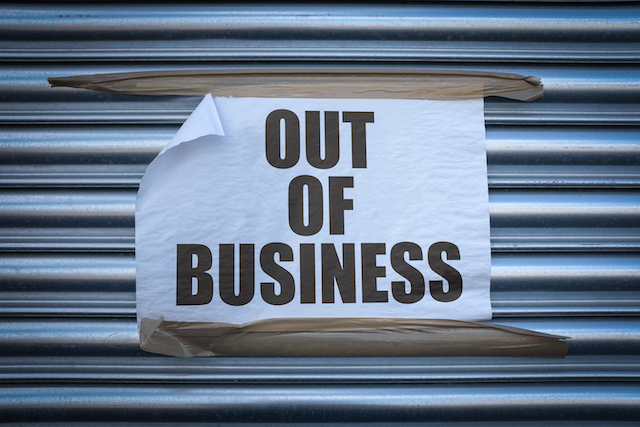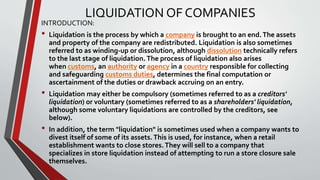Top Guidelines Of Company Liquidation
Top Guidelines Of Company Liquidation
Blog Article
What Does Company Liquidation Mean?
Table of ContentsCompany Liquidation Things To Know Before You BuyCompany Liquidation - The FactsThings about Company LiquidationAbout Company LiquidationSome Known Incorrect Statements About Company Liquidation Unknown Facts About Company LiquidationUnknown Facts About Company Liquidation
If the Statutory Settlement Need goes overdue, the financial institutions will certainly organise a winding-up petition to be approved with the courts. This essentially requests the court to enable the business to be sold off in order to pay the financial obligation. If the winding-up request is accepted, it will certainly be advertised in the Gazette and a selected bankruptcy professional will certainly sell off the company.Next off, the courts will accept a winding-up order if they think the lenders have the right to liquidate your company. The next phase of the process is the sale of firm properties, the distribution of funds and the closure of business - Company Liquidation. As soon as the business has been sold off, it's struck from the Firms Residence register
If any kind of wrongdoing is found, after that the Insolvency Service can disqualify the directors or take other ideal activity against them. The sees all properties sold in order to pay creditors, however not all creditors stand to make their refund. There's an appropriate sequence that bankruptcy practitioners should legitimately comply with as they disperse the funds made from the liquidation.
After they've taken their payment, after that protected financial institutions will be given their share of the profits. Company Liquidation. Guaranteed lenders frequently consist of financial institutions or any kind of lending institutions that have actually issued protected lendings to the organization. Next off, come the unprotected lenders. This includes workers and personnel that are still owed salaries, too any type of vendors that have given credit report in great belief.
Unknown Facts About Company Liquidation
The leads to the winding up of a service, with all assets offered to pay lenders and the firm eventually being struck from Firms House register. It's not a simple decision to make, yet for many companies a voluntary can be the finest means to shut down the organization.
When in progress, a CVL is under the efficient control of the creditors, that can select a liquidator of their choice. At this phase, the function of the supervisors is terminated. The Creditors Voluntary Liquidation process is made use of when a firm has actually come to the end of its useful life.

Whilst in the monetary distress phase, it is still possible to restructure and transform points around if aid is called swiftly enough, as our programs. However, if things do not boost, after that distress develops into a situation, which is when the firm's financial debt the cash that it owes to its creditors go to a degree which means that liquidation is the only actual choice.
Getting The Company Liquidation To Work
Our role is to supervise an orderly liquidation prior to we liquify it. For more details, assistance and advice about a Creditors Voluntary Liquidation, please The first assessment is FREE.

In a required liquidation the function of a liquidator remains in most instances originally carried out by an official called the. The Authorities Receiver is a policeman of the court and a member of the Insolvency Service, an exec firm within the In most compulsory liquidations, the Official Receiver becomes the liquidator immediately on the making of the winding-up order.
This occurs either at a conference of creditors convened for the function or directly by the Assistant of State. Where an insolvency specialist is not selected the Official Receiver continues to be liquidator. Where an obligatory liquidation adheres to right away on from an, the go to this site court may assign the previous manager to serve as liquidator.
Company Liquidation - An Overview
An administrator might also ultimately function as liquidator in a creditors' voluntary liquidation. For additional information, assistance and guidance concerning the Compulsory Liquidation process, please or call us on any of these numbers: Additionally K&W Healing, trading as Antony Batty and Business, Thames Valley:.
Your limited firm may be liquidated (wound up) if it can not pay people or organisations it owes money to (its financial institutions). This is a general overview just. You ought to also obtain professional advice from a solicitor, your accounting professional or an insolvency professional. When your company owes money the financial institutions might try to recoup the financial obligation by issuing an official demand for payment, called a statutory need.
The court issues a winding-up order if it determines your company can not pay its financial debts and is bankrupt. They will take control of the firm and its properties.
Company Liquidation - Truths
You and any various other of the business's directors need to co-operate with the liquidator. You can be outlawed from being a director for up to 15 years or prosecuted if you have actually failed to perform your tasks as a supervisor or damaged the regulation.
The firm liquidation process approaches navigating a long and winding road at night there are potential dead ends and stumbling blocks around every corner. That is, unless you have a bankruptcy expert in your edge to original site aid light the method. The beginning of the liquidation procedure signals the start of completion of a company as a lawful entity.
There are a variety of different choices to liquidate your firm, each with pros and cons. Required liquidation which is launched by financial institutions, Participants Voluntary Liquidation (MVL) for a tax-efficient leave from solvency, and Creditors Voluntary Liquidation (CVL) for business encountering insolvency. No issue which alternative is most proper for you, swift and decisive action is key.
Getting The Company Liquidation To Work

Generally, HMRC will be the primary creditor as a result of overdue taxes such as Company Tax, VAT, Pay As You Make (PAYE) or National Insurance Coverage Contributions (NIC). Trade lenders, such as suppliers, will certainly additionally be able to do something about it if they believe they are unlikely to be paid what they are owed.
If this takes place, it is essential that you act rapidly as time is going out to save your firm. Must there be no response to the Winding Up Request within 7 days of it being provided, your firm will certainly after that be sent out a Winding Up Order to require you to close.
Company Liquidation for Dummies
They will talk you with every one of the choices offered to you and suggest what they believe is the very best strategy for you to take. A MVL can be requested if your firm is solvent yet you still desire to close it down. It is one of the most popular option with entrepreneur as it is the most tax-efficient method to stop trading.
Report this page